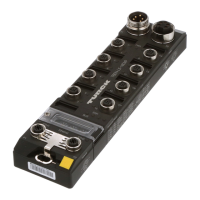65
2017/06
11 EtherNet/IP™
11.1 The EtherNet/IP™ Communications Profile
EtherNet/IP™ is based on a connection-oriented communication model. This means that it is only
possible to exchange data via specified connections assigned to the devices.
Communication between the nodes in the EtherNet/IP™ network can be carried out either via I/O
Messages or Explicit Messages.
I/O Messages
I/O Messages serve to exchange high priority process and application data over the network.
Communication between the slaves in the EtherNet/IP™ network is carried out according to the
Server/Client Model,
which means a producing application transmits data to another or a number of consuming applica-
tions. It is quite possible that information is passed to a number of Application Objects in a single
device.
Explicit Messages
Explicit Messages are used to transmit low-priority configuration data, general management data
or diagnostic data between two specific devices. This is a point-to-point connection in a Server/Cli-
ent System that requires a request from a client always to be confirmed by a response from the
server.
Message Router Response
Consists of a service code, path size value, a message router path and service data. An EPATH is
used in the message router path to indicate the target object.
Message Router Response
Consists of a service field with the most significant bit set. This is an echo of the service code in
the request message with the most significant bit set. A reserved byte follows the service code,
which is followed by the General Status code.
11.1.1 Communications Profile for TBEN-L
TBEN-L behaves as an EtherNet/IP™ Server in the network; the scanner of the higher-level controller
operates as a EtherNet/IP™ Client.
The following EtherNet/IP™ communications types are supported:
Unicast
Multicast
Cyclic Connection
Unconnected (UCMM) Explicit Messaging
Connected Explicit Messaging
Unicast
A point-to-point connection that exists between two nodes only.
Multicast
A packet with a special destination address, which multiple nodes on the network may be willing to
receive.

